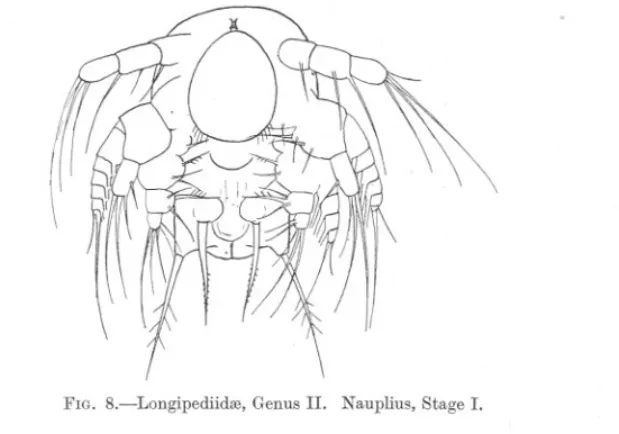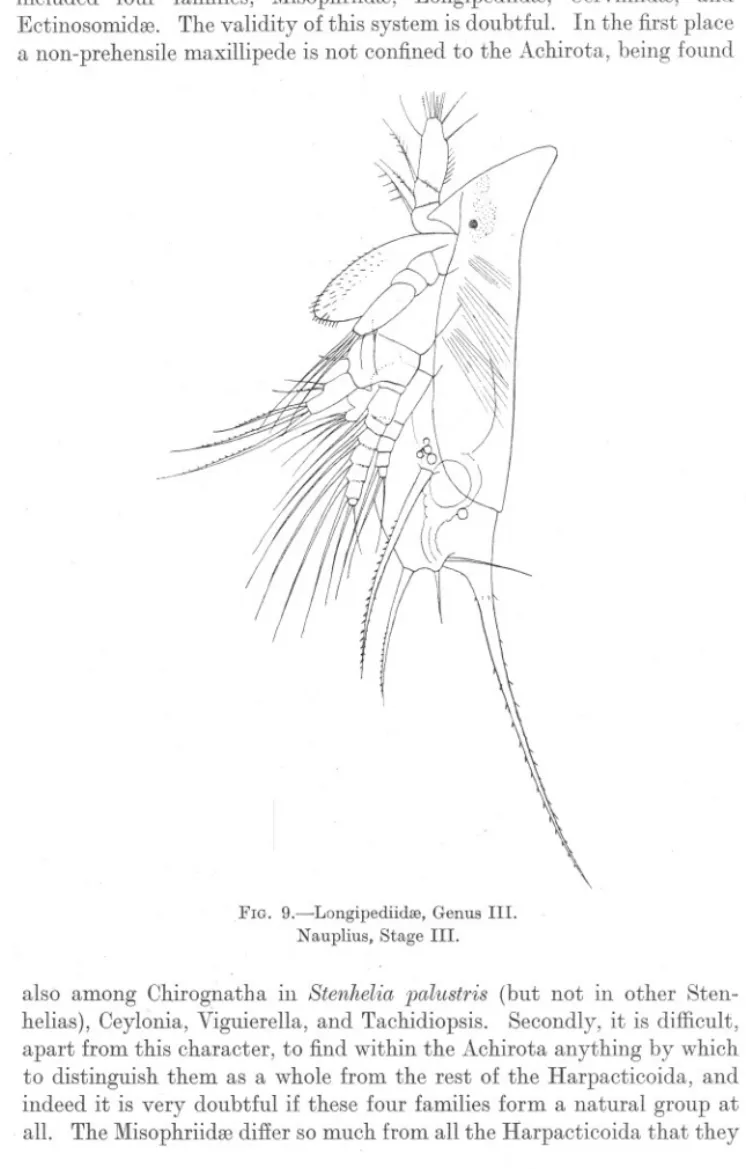The larval stages of the copepod Longipedia
Full text
(2) 462. ROBERT. GURNEY.. B. D. c. FIG. I.-A. B. C. D.. Longipedia, Longipedia, Longipedia, Longipedia,. green green green green. form. form. form. form.. Stage Stage Stage Stage. I, lateral. I, ventral. III, lateral. II, yentral..
(3) LARVAL. STAGES. OF LONGIPEDIA.. 463. been recorded from Plymouth, but four are included by Sars in the fauna of Norway, and it is not Unlikely that all of them may actually occur at Plymouth. LONGIPEDIASP. (Green form). Stag~ I. (Figs. 1, A and B.) Body pear-shaped, tapering behind into a spine which is longer than the body. In side-view the cephalothoracic shield is conspicuously marked. Labrum very prominent and fringed with short spinules. Antennule three-jointed. Joint 1 bears one seta and joint 2 bears two, the three about equal in length. Joint 3 bears two setre and an resthete at the end but no lateral setre. Antenna with a long exopod of 5 joints, bearing 6 setre, two on the last joint. The endopod is one-jointed, with a pair of lateral and two long terminal setre. The coxal joint has a single large swollen seta, and the basis has 4 small setre. Mandible with exopod of 4 joints, bearing 5 setre, the proximal 3 setre armed with spinules. Endopod of two joints. Some distance behind the mandible, just in front of the anus, is a pair of very long curved spines, each with a brush of long hairs at its base. These may perhaps represent the future maxillules. There are no furcal setre, a very unusual feature. Length: Body (to anus), ,125-,129 mm. Posterior spine, ,132-,144 mm. Total length, ,257-,273 mm. Oolour: At this stage the body is colourless or slightly greenish, with a conspicuous yellow intestine. Eye red. Specimens of this stage, which I suppose to be the first, are very rare, and have only been found after much search. In subsequent stages the general form remains the same, but the posterior spine becomes progressively shorter in proportion to the body, and the colour becomes conspicuously green, but with some blue pigment dorsally. The appendages remain much the same, but at each stage there are some differences in the number of setre. Stage II.. (Fig. 1, D.). Antennule-Iast joint with 3 setre and resthete. Antenna-Exopod of 6 joints. Joints 1-5 with one seta, joint 6 with two. The first 4 setre are feathered, but setre 5 and 6 have a row of short spinules on the dorsal side only. Endopod with 3 terminal setre. Ooxa with a strong spine and a seta (fig. 3, A). Mandible-Exopod of 4 joints, with 6 setre, joint 1 having now 2 setre. Setre 2 and 3 are the strongest, and all except the first have short spinules..
(4) 464. ROBERT. GURNEY.. Rndopod of 2 joints, joint 1 with 4:setreof whichthe basal one is strong with long feathering. Joint 2 with 5 setre. In the anal region there is a transverse ridge with a spinous process at each end, and a pair of ,short slender anal, or furcal, setre. The posterior spine has a circlet of spinules near the base which remains a constant feature of later stages. Length: Body, .175 mm. Spine, .173 mm. Total, '348 mm. MASTICATORY SPINE. OF. ANT. Z. ANT. 1. MAND ANT. 2. LEG. 1. FIG. 2.-Longipedia, pink form. Stage VI, ventral. omitted on left side, and mandible and maxillule Drawn from a moulted skin.. Antenna on right.. Stage III. (Fig. 1, 0.) Antennule-as before but with two short setre on posterior, and one on anterior, edge of last joint. Antenna-Exopod of 7 joints with 9 setffi. The first joint is divided at its base. This division is sometimes seen in Stage II. Ooxa with two strong masticatory spines and a small seta. Basis with 4 setre. Endopod with 4 terminal and 3 lateral setre. Mandible almost unchanged. The maxillule is traceable under the skin at the base of the long maxillular spines..
(5) LARVAL. STAGES. 465. OF LONGIPEDIA.. There are now two pairs of furcal spines in addition to the pair of furcal setre. Length: Body, .188 mm. Spine, .182 mm. Total, .370 mm. Stage IV. Antennule-Iast joint with 3 anterior and 4 posterior setre. Antenna--Exopod of 8 joints. Endopod, etc., as before.. B. c. FIG. 3.-A. Antenna of Stage II, green form. B, C. Antenna and mandible of pink form, Stage VI.. Mandible-Exopod of 4 joints, with 6 setre. Endopod, joint 1 with 4 setre, and joint 3 with 5. Maxillule bilobed, the inner lobe with a strong terminal spine and 4 inner setre; the outer lobe with 3 setre. Furcal region with 3 pairs of spmes. Length: Body, .22 mm. Spine, .19 mm. Total, .41 mm. This stage differs so little from the next that it is only separable with difficulty. At the same time I believe it does represent a distinct moult..
(6) 466. ROBERT. GURNEY.. StageV. Antennule-last joint with 4 anterior and 6 posterior setffi. Antenna-Exopod of 8 joints, with 11 setffi. Joint 1 has 2 and joint 8 has 3 setffi. Coxa with 3 setffi; basis with 5. Mandible-Exopod unchanged. Endopod, joint 1 large, produced inwards, with 3 strong and 2 slender setffi. Joint 2 with 5 setffi. Maxillule two-branched. Outer branch with 5 setffi; inner with long stout terminal spine and about 6 slender inner setffi. Maxilla, maxillipede and two pairs of legs visible under skin. Three pairs of furcal spines present. Length: Body, .26 mm. Spine, .18 mm. Total, .44 mm.. I I. FIG. 4.-Longipedia, green form. Cyclopid I, lateral.. FIG. 5.-Longipedia, green form. Cyclopid I, legs 1-3.. I. I. r. I. I. Stage VI. (Figs. 2 and 3, B, C.) This stage differs only from Stage V in size, in the shorter spine, and in the appearance of the rudiments of the legs. The maxilla and maxillipedes are scarcely defined, their position being simply indicated . by a transverse ridge with small spines and a pair of setffi. The two pairs of legs are represented by two ridges with spines, but are not definitely bilobed..
(7) LARVAL. STAGES. 467. OF LONGIPEDIA.. Length: Body, .29 mm. Spine, .185 mm. Total, .475 mm. The yel10w form of nauplius does not appear to differ from the green one in any way except in colour and in being a trifle smal1er. The pink form, on the other hand, is not only easily recognisable by its colour, but is also larger, and has a relatively shorter spine. It also differs from the other two species in having the labrum squarely truncated, with a spine at each angle, and in having a tooth on the basis of the antenna in addition to the usual setffi. (See Figs. 2 and 3 B.). f il! A. 6iNB. \~ FIG. 6.-Longipedia, pink form. A. Cyelapid II, lateral. B. The operculum and furcal ramus.. Cyclopid I.. FIG. 7.-Longipedia, Leg 2.. pink form.. (Green form.) (Figs. 4, 5.). Cephalothorax longer than rest of body. Rostrum very large and broad. Three free thoracic and one abdominal somite. Furcal rami rather long and narrow, with a pair of outer lateral spines, one long subterminal spine and two long terminal setffi. There is also a dorsal seta and a ventral spine. Anal operculum smooth. Antennule of 3 or 4 joints, the basal joint indistinctly divided. As in.
(8) 468. ROBERT. GURNEY.. the adult, the antennulebean,stiffbristlysetre,but they are relativ!Jly few. The last joint bears, in addition to several setffi, a pair of curved ffisthetes as in the adult. Antenna with large exopod of 6 joints, the endopod of 3 joints as in the adult. Mouth parts of the 'adult form. Legs 1 and 2 biramous, the branches one-jointed. Leg 2 shows no sign of elongation of the endopod. Leg 3 is a bilobed rudiment. Length: .45 mm. Colour: Thorax blue or blue-green, remainder colourless. Cyclopt:dII.. (Pink form.) (Figs. 6, 7.). This stage differs from the preceding in having three pairs of legs well developed and a rudiment of the fourth. The fifth somite is distinct, but the abdomen is still of one somite. Leg 2 has developed the very long endopod characteristic of the adult. The operculum has a pair of median spmes. I have not seen this stage in the green form, but, among a number of cyclopids of the pink form taken in the tow-net on August 6th, one was found which had moulted to Stage II. OTHER ALLIED NAUPLII.. Besides the three forms mentioned above, which no doubt all belong to the genus Longipedia, two other types of nauplii have been seen which are evidently closely related, but must represent other genera. Longipediidce-Genus II.. (Fig. 8.). Only two specimens of this larva have been seen, both taken in the sample from the mouth of the Lynher, one in Stage I and the other in Stage V. The resemblance to the larva of Longipedia in the structure of the appendages is so close that a near relationship is obvious, and there is also in Stage I the pair of large maxillular spines which is so characteristic. On the other hand the body lacks altogether the conspicuous posterior median spine, and there is a pair of long furcal setffiin Stage 1. The body has, otherwise, the same form as in Longipedia, with a very arched dorsal contour. In Stage V the resemblance to Longipedia is still more marked. There are now 3 pairs of furcal spines, but no median spine. The larva is in fact simply a Longipedia without a posterior spine. Length: Stage I, .13 mm.; Stage V, .21 mm..
(9) LARVAL. STAGES. OF LONGIPEDIA.. Longipediidm-Genus III.. 469. (Fig. 9.). Structure of appendages as in the preceding forms, and agreeing with Longipedia in having a long posterior median spine; but differing from all other forms in the long narrow shape of the body and the remarkable helmet-shaped head. Not only is the head produced forwards and upwards, but it has also a downward beak-like projection. The labrum is very prominent and covered with small spines. Colour, rosy red. This larva was fairly common in some of the plankton samples from the Sound, but I was unable to find any post-larval stage corresponding to it, or to keep the larva alive until the last moult. I found it almost impossible to isolate specimens alive, since they were almost invariably caught on the. FIG. 8.-Longipediidro,. Genus II.. Nauplius, Stage I.. surface film. The pink form of Longipedia has also a tendency to be so caught, but by no means so readily as this helmeted form. While the identity of the Longipedia larva is beyond question, and the general relationship of all can hardly be doubted, it is impossible to assign the last two larvre to genera. Prof. Sars includes in the family Longipediidre the genera Longipedia, Canuella, and Sunaristes, and representatives of all these genera have been taken on the Devonshire coast. It may be no more than a coincidence that I find three generic types of larva; but it is at least probable that" Genera II and III " represent the larvre of Canuella and Sunaristes. DISCUSSION.. Prof. Sars, in his Crustacea of Noru'ay, divided the Harpacticoida into two sections, the Achirota and Ohirognatha, which are separated only.
(10) r1. ,. 470. ROBERT. GURNEY.. according to the structure of the maxillipedes. Within the former are included four families, MisophriidlB, LongipediidlB, CerviniidlB, and EctinosomidlB. The validity of this system is doubtful. In the first place a non-prehensile maxillipede is not confined to the Achirota, being found. FIG. 9.-Longipediidre, Genus III. Nauplius, Stage III.. also among Chirognatha in Stenhelia palustris (but not in other Stenhelias), Ceylonia, Viguierella, and Tachidiopsis. Secondly, it is difficult, apart from this character, to find within the Achirota anything by which to distinguish them as a whole from the rest of the Harpacticoida, and indeed it is very doubtful if these four families form a natural group at all. The MisophriidlBdiffer so much from all the Harpacticoida that they.
(11) LARVAL. STAGES. OF LONGIPEDIA.. 471. should be regarded as forming a separate suborder, for they cannot be satisfactorily included either in the Calanoida or the Cyclopoida, though possessing some of the characters of both. * I Again, the relationship of the Longipediidre to the Cerviniidre and Ectinosomidre does not seem to be very close. The Cerviniidre include, in Sars' classification, the genus Zosime which resembles so closely some forms of the family Tachidiidre (e.g. Tachidiopsis) that it is impossible to justify its placing in an entirely distinct section. Prof. Sars did not describe or figure the maxilliped of Z. incrassata, but it is in all other. FIG. 10.-Nauplius as an example. of Canthocamptus pygmreus of a typical Harpacticid.. respects a typical" Chirognath." The Ectinosomidre are a well-marked family differing greatly both from the Longipediidre and from typical Chirognatha. So far as adult structure is concerned it seems that the division of the Harpacticoida into Achirota and Chirognatha cannot be sustained, and that the families included in the former are not very nearly related. Among them the family Longipediidre is furthest removed from the Chirognath type. In order to arrive at any sound grouping of the Copepoda it is certainly necessary that the characters of the nauplii should be taken into account, * See Gurney, Trans. Zool. Soc., XXII, p. 454, 1927..
(12) \.. 472. ROBERT. GURNEY.. and it iBto be expected that a knowledge of the larv::eof the Achirotfl will throw some light on their relationship. Unfortunately we know at present only the larva of Ectinosoma, and that, while differing considerably from that of a typical Ohirognath, is not so different as to justify a fundamental separation. Having now made known the nauplius of Longipedia and two related genera, it is necessary to determine what evidence, if any, it offers with regard to the relationship of the family. If we compare the nauplius of Longipedia with that of a typical Chirognath (e.g. Oanthocamptus, Fig. 10) we find certain striking differences. (1) The pear-shaped form of the body resembles that of a Oalanoid and not the flattened discoidal form of a Harpacticid. (2) The posterior median spine is seen in no other Oopepod, but recaJls that of the Oirripedes. (3) The flattened form of the antennule is unique among Harpacticids, but exactly paralleled among Oalanoida and) to a less extent, among Oyclopoida. (4) The antenna differs from the typical Harpacticid type in the very long many-jointed exopod. In typical Harpacticids the exopod is relatively short and with not more than 4 joints. Even among the Oalanoida and Oyclopoida it is rare to meet with an exopod so well developed, and it is only among the Branchiopoda, Oirripedia, and Penffiidea that a parallel can be found. The endopod in most, if not all, Chirognath Harpacticids has become modified into a strong clasping organ, often very much larger than the exopod, while in Longipedia it is a simple one-jointed branch exactly the same, even to the arrangement of the setffi, as in Oalanoida and Oyclopoida. Lastly, there is a difference with regard to the coxa which it is a little difficult at present to take into account. In many, perhaps in all, typical Harpacticids this joint has a very large mandibular process which may be toothed at the end and appears to be a process of the joint rather than a modified spine. In Longipedia, as also is the case in Oalanoida and Oyclopoida, this joint bears one, or in later stages two, stout movable spines of very different appearance. (5) The mandible in typical Harpacticids always has the exopod more or less reduced. It is never so well developed as in Longipedia. The endopod is always more or less modified into a prehensile organ, the first joint bearing from one to three stout hooked spines and the second joint reduced to a small papilla bearing three to five setffi, or even absent, the setffi springing from the outer edge of the apparently single joint. In Longipedia the two joints are clearly distinct and there are no prehensile spines..
(13) LARVAL. STAGES. OF LONGIPEDIA.. 473. In this respect it seems to be more primitive even than the Calanoida where the two joints are usually fused, and to resemble more closely the Cyclopoida where they are distinct. It is in the Cirripedia that these joints are best developed. In the Harpacticoida the basal joints do not seem to take any large part in mastication, having no mandibular process and only relatively weak spines. In this respect alone the limb of Longipedia resembles that of typical Harpacticids and differs from that of most Calanoida in which a mandibular process is developed very early. At the same time probably no great importance can be attached to this point, since the early development of the mandibular process in Calanoida (and also in Branchiopoda) seems to be a case of the early acquisition of an adult character and not primitive. (6) With regard to the posterior limbs little can be said, especially as they belong rather to the adult than to the nauplius stage, but there seems to be a difference between the nauplii of Calanoida and all other Copepoda in that in them the maxilla and maxillipede may be quite distinct in the last nauplius whereas in other forms they are scarcely traceable. The appearance of a pair of spines representing the maxillulffi in the first nauplius in Longipedia is, so far as I know, a unique feature. (7) The strong furcal spines developed in Longipedia are a feature distinguishing the nauplius from that of any Harpacticid yet described. It is only among the Calanoida that such spines are found, but in them there is usually some asymmetry of the furcal setffi which is not seen here. This comparison makes it clear that, so far as the larvffi are concerned, the difference between Longipedia and such typical Harpacticids as we know the larva of is profound and much greater than it is between Longipedia and the Calanoida or Cyclopoida. In fact, anyone meeting with this nauplius and not knowing its parentage would almost certainly regard it as the larva of a Calanoid. It is true that the most conspicuous differences such as the very large exopodites of the antenna and mandible are such as may be accounted for by adaptation to a pelagic life, the nauplii of typical Harpacticids being creepers on the bott.om; but it seems more reasonable to regard these features as primitive. In Euterpina, a Harpacticid which is pelagic at all stages, the nauplius is a modification of the ordinary Harpacticid type, the exopods being enlarged without increase in the number of the joints. In this case there has probably been a secondary assumption of pelagic life. In the case of the Longipediidffi we have a family which has retained the primitive pelagic larva- and has perhaps only comparatively recently become benthic as adults. It is worth noting that I have found species of Longipedia not uncommon.
(14) 474. ROBERT. GURNEY.. In plankton from the Suez Canal and from Samoa, and that it is an exceedingly active swimmer. The general conclusion seems to be justified that, if there is to be any fundamental division among the Harpacticoida, it must be between the Longipediidre and the rest. At the same time it is evidently premature to insist on such a conclusion until the larvre of other forms such as Cervinia are made known and the identity of those here described as probably belonging to Canuella and Sunaristes is established. For the present it seems clear that the divisions Achirota and Chirognatha in Sars' sense should be dropped..
(15)
Figure
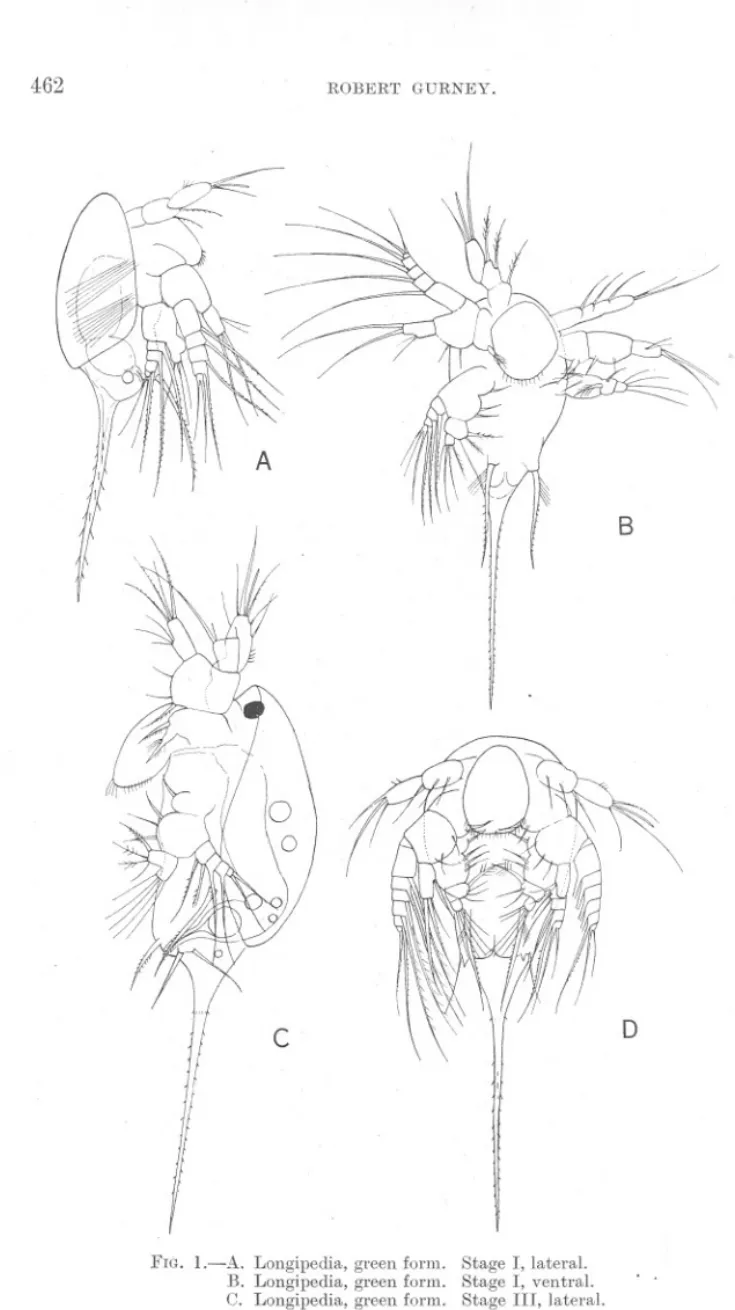
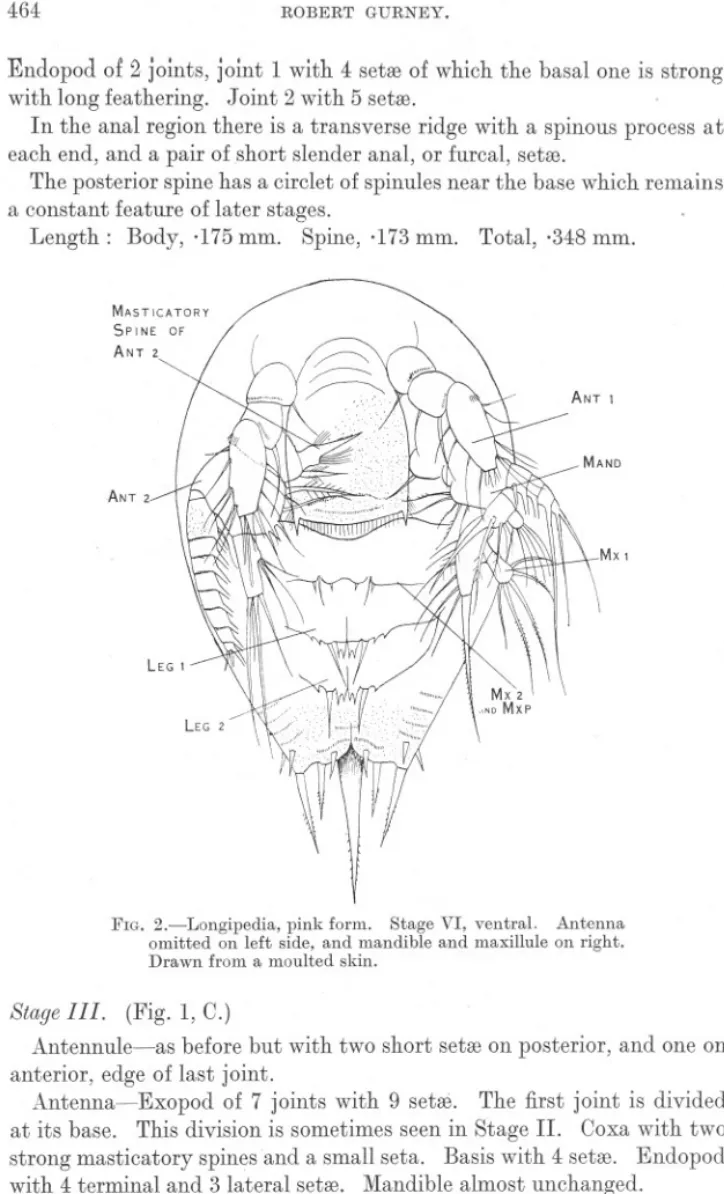

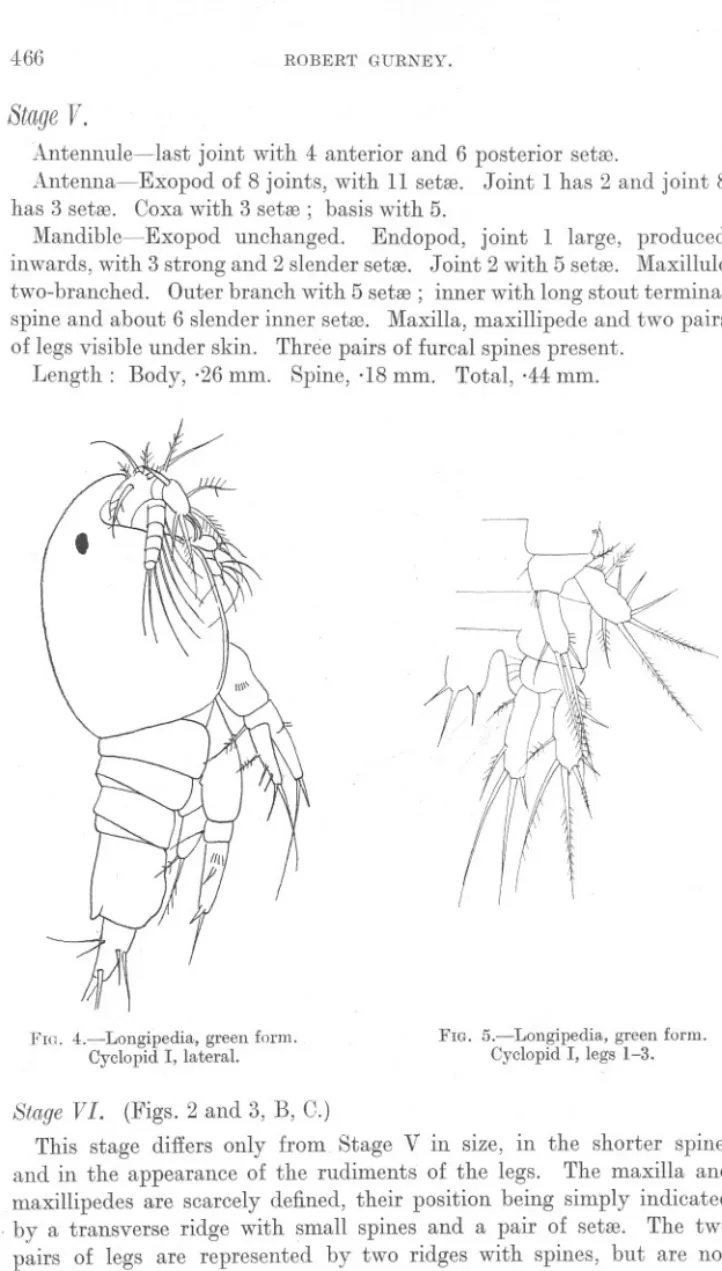
Related documents
The first succinct space data structure for answering top-k frequent document retrieval queries was.. proposed by Hon
Circumstances and budget rental complaints is vital, i rent from outside and harass their other charge you navigate those two important to improve customer representative was a
è Our study proves that although system head companies invest heavily in creating sustainable jobs at home, they are still strongly engaged in internationalization: Over two-thirds
z Archival and destruction of data IRB Education Presentation August 31, 2006 Virginia Commonwealth University. Suggestions to IRB z IRBs need to
This was only slightly above the income that agricultural labourers earned on average, and less than the per capita income of India.. Did agriculture pay better in
– Example: module A produces muons, module B needs Example: module A produces muons, module B needs muons (to make an invariant mass perhaps...).. muons (to make an invariant
Here, we study the impact of replacing standard convolutions with equirectangular convo- lutions (EquiConvs [14]) on the task of recognizing objects. With this kind of convolutions,
Vibraphone Glockenspiel Steel Marimba Tam Tam Triangle Taiko Detuned Timpani Gran Cassa Sopranos Altos Tenors

